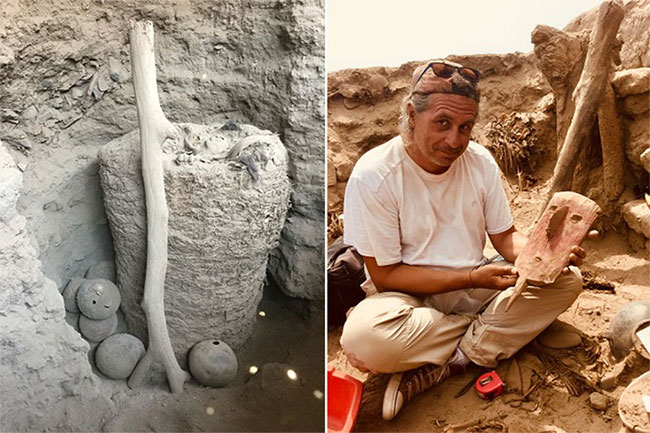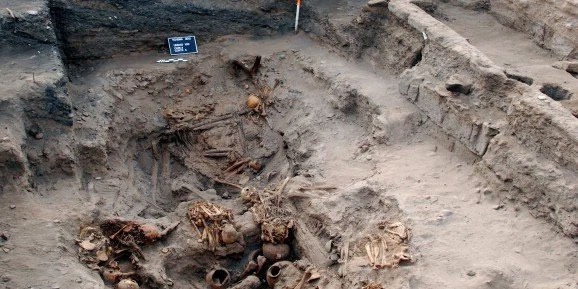In 2018, a team from the archaeological research center of the Free University of Brussels (CReA-Patrimoine) completed a significant excavation at Pachacamac, Peru. Here, they discovered a well-preserved intact mummy.
Based on evidence and examination results, the experts confirmed that this tomb was buried between the years 1000 and 1200, meaning it has existed for over 1000 years. According to the specialists, the deceased was wrapped in a large fabric bundle used as a coffin.
However, the experts uncovered a strange phenomenon within this thousand-year-old tomb. The bones in the tomb were meticulously arranged, with the skeleton of an adult carefully placed in the center. Surrounding this skeleton were the remains of many others, primarily children, but arranged in a chaotic manner.

Excavation team leader Peter Eeckhout, on the right, and a part of the ancient tomb at Pachacamac. (Image: Peter Eeckhout)
Archaeologists noted that the remains of the children were positioned in an extremely unusual manner within the tomb. They were placed in a specific position with some intent. Eckhout believes this represents a form of “rebirth in the afterlife.” Some of them may have died from natural causes such as illness, while others might have been used for religious activities like sacrifice.
Peter Eeckhout, an archaeologist at the Free University of Brussels in Belgium, leads this team of scientists. He suggests that according to their findings, the upper part of the tomb was covered with fabric and grave goods. It is very likely to be the resting place of pilgrims.
These pilgrims traveled a long distance in search of a legendary cure for all ailments and ultimately died from various diseases.

The tomb with scattered skeletons. (Image: Science Blog).
Archaeologists also found a mysterious object in the tomb, a “dummy head” made of wood. According to on-site statistics, there were five such heads, but these were not wrapped in fabric; instead, they were stuffed inside the body of a mummy. This sight horrified the archaeologists.
Regarding the form of this mysterious tomb, anthropologist Matthew Piscitelli from the University of Illinois believes: “These dummy heads may have been used as a sacrificial offering to guide the deceased to the afterlife.”
As for the bones of the children in the tomb, Eckhout stated that it cannot be ruled out that they were used in ritual activities. However, experts have yet to reach a final conclusion regarding this arrangement. It is undeniable that this thousand-year-old tomb has added another unsolved mystery to the area.


















































